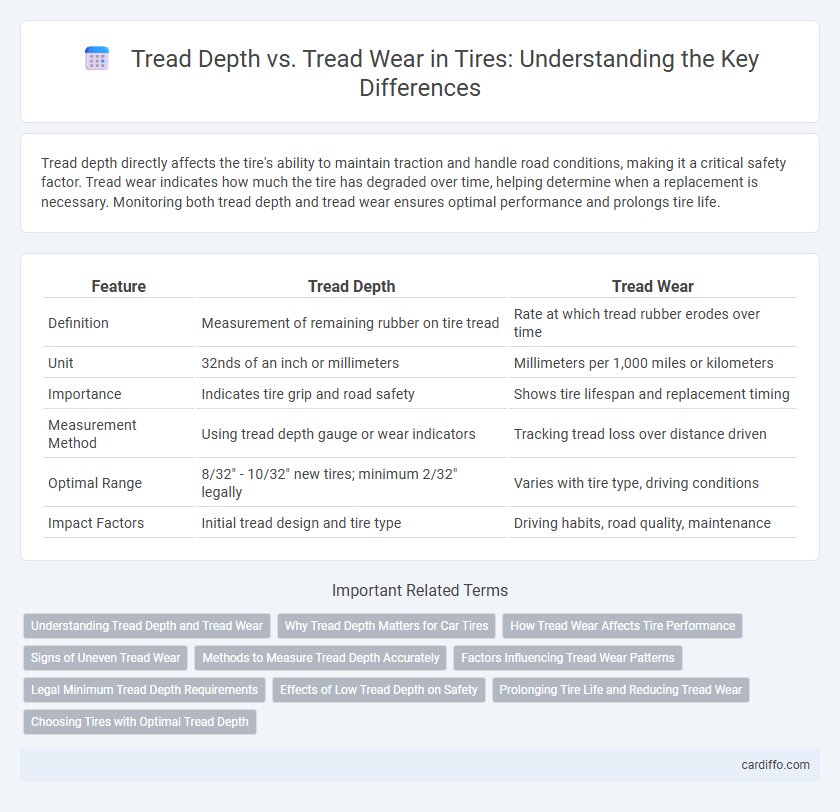Tread depth directly affects the tire's ability to maintain traction and handle road conditions, making it a critical safety factor. Tread wear indicates how much the tire has degraded over time, helping determine when a replacement is necessary. Monitoring both tread depth and tread wear ensures optimal performance and prolongs tire life.
Table of Comparison
| Feature | Tread Depth | Tread Wear |
|---|---|---|
| Definition | Measurement of remaining rubber on tire tread | Rate at which tread rubber erodes over time |
| Unit | 32nds of an inch or millimeters | Millimeters per 1,000 miles or kilometers |
| Importance | Indicates tire grip and road safety | Shows tire lifespan and replacement timing |
| Measurement Method | Using tread depth gauge or wear indicators | Tracking tread loss over distance driven |
| Optimal Range | 8/32" - 10/32" new tires; minimum 2/32" legally | Varies with tire type, driving conditions |
| Impact Factors | Initial tread design and tire type | Driving habits, road quality, maintenance |
Understanding Tread Depth and Tread Wear
Tread depth measures the distance between the tire's surface and the bottom of its grooves, indicating how much rubber remains to provide traction. Tread wear refers to the gradual loss of this depth due to friction and driving conditions, affecting tire performance and safety. Monitoring tread depth regularly helps detect excessive tread wear early, ensuring optimal grip and reducing the risk of hydroplaning.
Why Tread Depth Matters for Car Tires
Tread depth directly impacts a tire's grip on wet and slippery roads, enhancing safety by reducing the risk of hydroplaning. Adequate tread depth ensures optimal water evacuation, maintaining traction and control in adverse weather conditions. Monitoring tread wear helps drivers identify when tires have worn down to unsafe levels, preventing potential accidents due to diminished road contact.
How Tread Wear Affects Tire Performance
Tread wear significantly reduces tire performance by decreasing traction and increasing stopping distances, especially on wet or slippery surfaces. As the tread depth diminishes below the legal minimum of 2/32 inches, the risk of hydroplaning and loss of control escalates, compromising safety. Regular monitoring of tread wear indicators ensures optimal vehicle handling and tire longevity.
Signs of Uneven Tread Wear
Uneven tread wear often indicates alignment issues or improper tire inflation, significantly affecting tire performance and safety. Signs include tread wearing more on one side than the other, patchy or scalloped areas, and faster wear in the center or edges of the tire. Monitoring tread depth regularly helps detect these anomalies early, preventing further damage and maintaining optimal traction and fuel efficiency.
Methods to Measure Tread Depth Accurately
Accurate measurement of tread depth is essential for assessing tire wear and safety, typically achieved through tools like tread depth gauges, which provide precise numeric readings in millimeters or 32nds of an inch. Digital tread depth gauges enhance accuracy by offering digital displays and consistent pressure application, reducing human error common with manual gauges or coin tests. Regular tread depth checks using these methods help monitor tire wear patterns and determine when tire replacement is necessary to maintain optimal traction and road safety.
Factors Influencing Tread Wear Patterns
Tread depth is a critical measurement indicating the remaining rubber on a tire's surface, directly affecting vehicle traction and safety. Tread wear patterns are influenced by factors such as vehicle alignment, tire pressure, driving habits, and road conditions, which can cause uneven or accelerated wear. Regular monitoring of tread depth and understanding these underlying factors help optimize tire performance and lifespan.
Legal Minimum Tread Depth Requirements
Legal minimum tread depth requirements vary by region, typically set at 1.6 millimeters (2/32 inches) to ensure adequate traction and safety. Tires with tread depths below this threshold significantly increase the risk of hydroplaning and reduce braking efficiency, leading to potential legal penalties. Regularly measuring tread wear helps maintain compliance with these regulations while optimizing tire performance and vehicle safety.
Effects of Low Tread Depth on Safety
Low tread depth severely diminishes tire traction, increasing the risk of hydroplaning on wet surfaces and compromising vehicle control. Worn tires with reduced tread depth also extend braking distances, raising the likelihood of collisions in emergency stops. Maintaining adequate tread depth is crucial for optimal grip, stability, and overall road safety.
Prolonging Tire Life and Reducing Tread Wear
Maintaining optimal tread depth is crucial for prolonging tire life, as deeper treads enhance traction and distribute stress more evenly across the tire surface. Regularly monitoring tread wear patterns helps identify alignment or inflation issues early, preventing uneven wear and extending tire durability. Proper tire maintenance, including rotation and balancing, significantly reduces tread wear, ensuring safer driving and maximizing tire lifespan.
Choosing Tires with Optimal Tread Depth
Selecting tires with an optimal tread depth of at least 8/32 inch enhances traction and safety, especially on wet or slippery surfaces. Monitoring tread wear using a tread depth gauge helps determine when replacement is necessary to maintain vehicle performance. Choosing tires that balance durability and sufficient tread depth ensures longer tire life and improved road grip.
Tread depth vs tread wear Infographic

 cardiffo.com
cardiffo.com